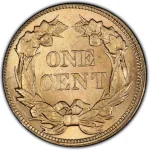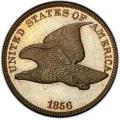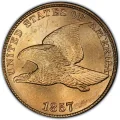- United States Coins
- Flying Eagle Pennies
Flying Eagle Pennies
 Flying Eagle pennies were the first small cents, which replaced large cents beginning in 1857. The reason for the reduction of the one-cent coin’s diameter came largely as a result of inflation. Copper prices rose to the point that minting the large one-cent coin became almost unprofitable for the United States Mint. Rising prices also affected the popularity of the large-size one-cent coin in circulation. Many individuals did not like having to carry around increasing numbers of these relatively large and heavy copper coins to pay for purchases, and thus the large cent was widely shunned by the public as the 1850s came around. Bear in mind, large cents were, at one point, nearly as large in diameter as a modern-day half dollar.
Flying Eagle pennies were the first small cents, which replaced large cents beginning in 1857. The reason for the reduction of the one-cent coin’s diameter came largely as a result of inflation. Copper prices rose to the point that minting the large one-cent coin became almost unprofitable for the United States Mint. Rising prices also affected the popularity of the large-size one-cent coin in circulation. Many individuals did not like having to carry around increasing numbers of these relatively large and heavy copper coins to pay for purchases, and thus the large cent was widely shunned by the public as the 1850s came around. Bear in mind, large cents were, at one point, nearly as large in diameter as a modern-day half dollar.
The first small cents were made in 1856 as a pattern coin, with several examples being sent to Congress and a few to President Franklin Pierce. The new coin gained wide acceptance, and at least a few hundred pieces were distributed into circulation channels, even though the coin wasn’t officially authorized as a monetary issue until 1857. Small cents from 1856 are exceedingly rare, as only around 2,000 were made. The following year saw the end of large cent production; most of the 333,456 large cents minted in 1857 remained at the Philadelphia mint and were later melted. That year, millions of Flying Eagle cents were struck and enjoyed widespread use in circulation.
As a numismatic side note, 1857 was also the year the U.S. government removed legal tender status from Spanish colonial dollars, which widely circulated throughout the U.S. at that time. Though no longer considered legal tender, they could be exchanged over a period of two years for the new copper-nickel pennies.
Flying Eagle cents would be minted as official coinage for just two years – 1857 and 1858. In 1859, Flying Eagle pennies were replaced by Indian Head pennies. Both series, by the way, were designed by Chief Engraver of the United States Mint James B. Longacre, who had become one of the most widely acclaimed artists in the nation. Flying Eagle pennies and Indian Head pennies are popular collectibles today, and they are often collected together.
Flying Eagle pennies are, for the most part, considered numismatically common and can be purchased in well-circulated grades for starting at $25 each. Meanwhile, the 1856 Flying Eagle penny retails for a minimum of $8,750. In 2004, an MS 66 specimen sold for $172,500.
Below is a list of Flying Eagle Penny info sheets for each year of issue. Each info sheet includes detailed pricing and mintage numbers for each variant.
-
{{#owner}}
-
{{#url}}
{{#avatarSrc}}
{{name}} {{/url}} {{^url}} {{#avatar}} {{& avatar}} {{/avatar}} {{name}} {{/url}} - {{/owner}} {{#created}}
- {{created}} {{/created}}



